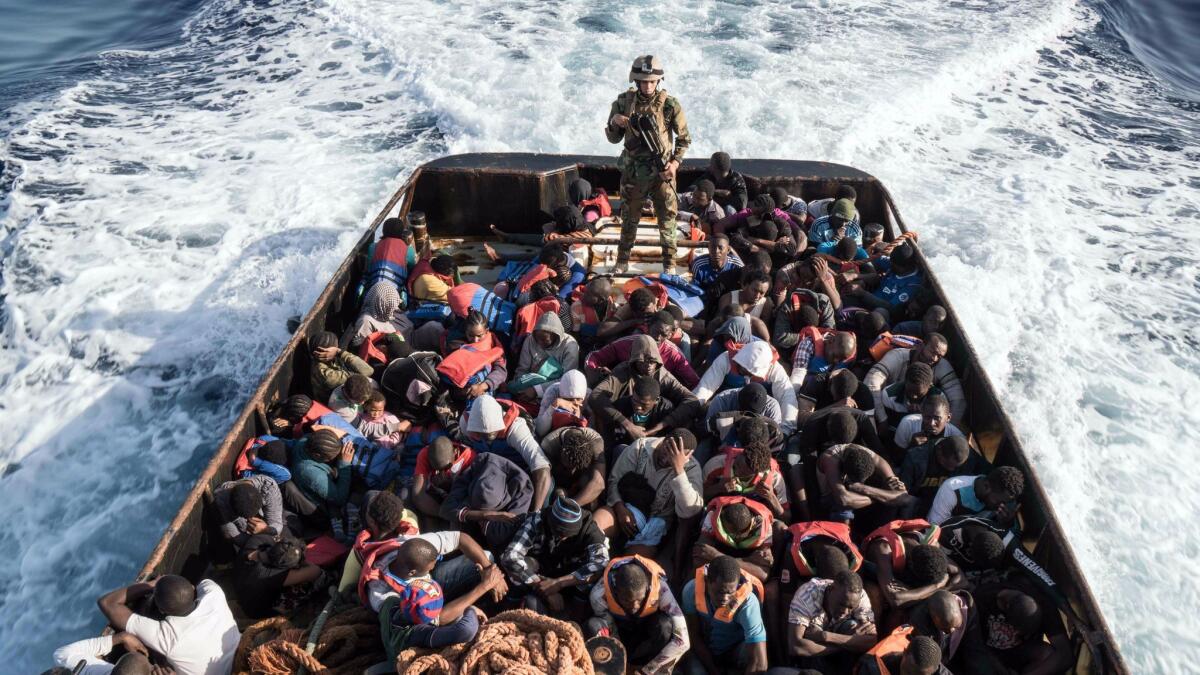Europe’s migrant crisis threatens to overwhelm Italy, even as flows to Greece dry up

Europe’s unrelenting
More than 85,000 people fleeing poverty and violence have risked the perilous Mediterranean crossing to reach Italy this year, a 20% increase over the same period in 2016, according to figures from the International Organization for Migration. At least 2,150 others have died trying.
The surge has inflamed a long-standing dispute over the way
Italian officials, who have been among the more welcoming in Europe, threatened last week to close their ports to rescue ships operated by humanitarian groups that weren’t flying the Italian flag unless they received more help from other EU members.
On Tuesday, Austrian defense officials said they were prepared to use armored vehicles and troops to prevent migrants from crossing the border from Italy.
The
“Italy is playing its part in receiving those rescued and providing asylum to those in need of protection,” he said in a statement Saturday. “But this cannot be an Italian problem alone. It is, first and foremost, a matter of international concern.”
Until last year, many of those trying to reach Europe were Syrians using the shorter route from Turkey to the Greek islands. But the number of arrivals there has plunged since the EU struck a deal with Turkey in March that year to stem the flow. More than 9,200 have made the crossing this year, compared with 158,000 in the first half of 2016.
The rest of the arrivals by sea have been shared between Spain and Cyprus, which as of Monday had received 6,464 and 273, respectively.
Why are migrants headed to Italy?
Italy has long been a destination for those hoping to reach European shores because of its proximity to North Africa, and specifically the lawless nation of Libya, which in recent years has become a launchpad for Mediterranean crossings.
Most of these migrants come from sub-Saharan Africa. According to UNHCR, the top two nationalities arriving in Italy by sea in 2016 were Nigerians (21%) and Eritreans (11%).
Nigeria, Africa’s most populous nation, is facing its worst economic crisis in decades and a deadly uprising by the militant group Boko Haram, while Eritrea has a notoriously repressive government that migrants accuse of imposing a system of forced labor and governing by fear.
Libya was itself a destination for migrants under longtime strongman Moammar Kadafi, who needed labor for his oil-rich nation. But Kadafi’s ouster in 2011 plunged the country into violent chaos, spurring many foreigners to take their chances on overloaded boats to Europe.
The number of Mediterranean crossings often increases during the warm summer months, but U.N. officials say the recent surge is exceptional. More than 12,000 people were plucked from the sea over four days last week.
Officials note another striking feature: the high number of children who make the journey alone or get separated from their parents along the way.
We are under pressure, and we ask for a concrete contribution from the Europeans.
— Italian Prime Minister Paolo Gentiloni
How is Italy handling the influx?
The Italian Coast Guard has taken the lead on efforts to rescue migrants stranded at sea. The survivors are taken to reception centers, where they are allowed to apply for asylum.
But Italian officials say they are getting overwhelmed and are stepping up pressure on their European counterparts to share the burden.
Last week, Prime Minister Paolo Gentiloni warned that unless other countries do their part, the growing number of migrants could fuel a public backlash and position euroskeptic populist parties for victory in national elections expected within the next year.
"Italy has never ducked its commitments and it does not intend to do so,” Gentiloni told reporters in Berlin. But he added, “We are under pressure, and we ask for a concrete contribution from the Europeans.”
Many of those who apply for asylum in Italy do not qualify, and officials have promised to build more detention facilities for migrants and step up deportations.
What’s the rest of Europe doing to help Italy?
Under EU rules, asylum seekers are supposed to apply for protection in the first member country they reach.
At the height of the migration crisis in late 2015, EU leaders set up a quota system to try to relocate up to 160,000 asylum seekers from Greece and Italy within two years. But some countries refused to take part, and officials say the number of people resettled will fall far short of the goal.
European leaders are now trying to mobilize resources to help Italy cope with the growing number of migrants. The EU’s executive branch announced nearly $40 million in additional aid for the country on Tuesday.
The European Commission said it would also raise more than $50 million for an initiative to help Libya reduce the flow of migrants headed to Italy. Efforts under discussion include making improvements to the camps that house migrants in that country, strengthening border controls and supporting the Libyan coast guard.
Germany and France are promising to increase their efforts to help relocate those migrants in need of protection, according to a joint declaration with the EU commission Monday. But Austria is threatening to take a less-welcoming stance.
An Austrian defense ministry spokesman told the Reuters news agency Monday that four armored vehicles had already been deployed to its border with Italy and some 750 troops were poised to be deployed within 72 hours to deal with any emergencies. Other Austrian officials, however, said there was currently no need for such measures.
Twitter: @alexzavis
Twitter: @AMSimmons1
Sign up for Essential California
The most important California stories and recommendations in your inbox every morning.
You may occasionally receive promotional content from the Los Angeles Times.









